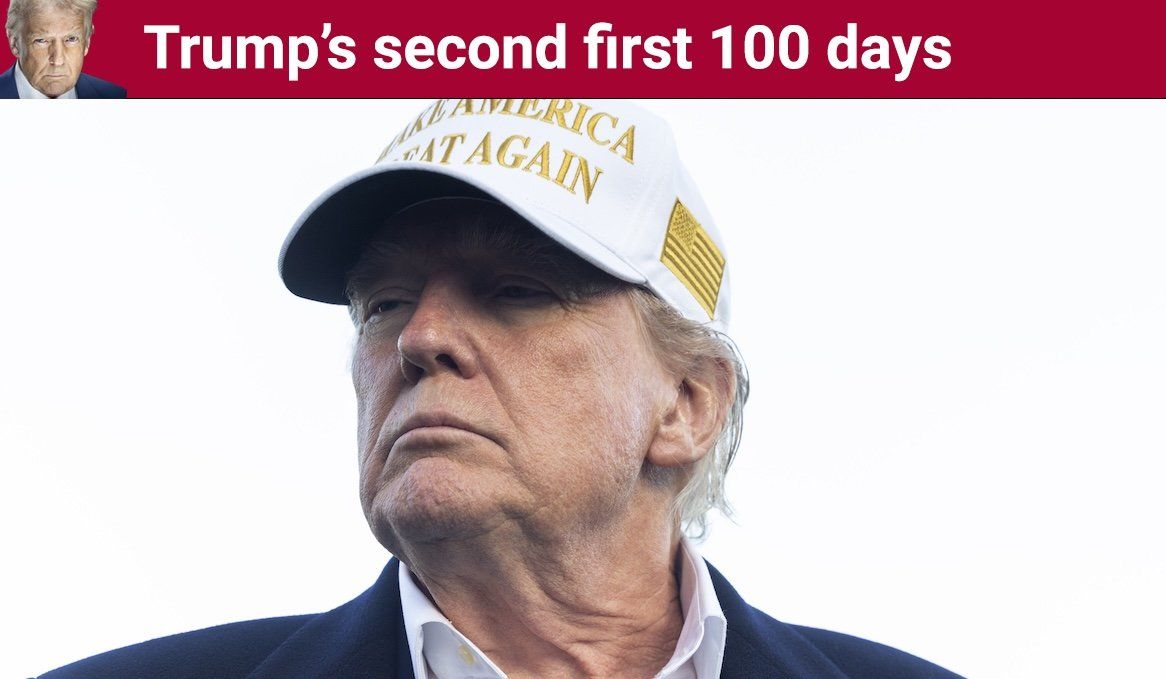US President Donald Trump returns to the White House from his New Jersey golf club to Washington, DC, on April 27, 2024.
President Donald Trump has claimed a broad mandate to pursue sweeping changes to US institutions and policies since he took office on Jan. 20. He has sought to overhaul the federal government by closing agencies and cutting thousands of jobs, restructure the economy by throwing up a tariff wall to force companies to base more of their operations in the US, reconfigure decades-old foreign alliances, and assert expansive powers in an illegal immigration crackdown.
With a cohesive team in the White House, Republican control of Congress, and a disoriented Democratic opposition, Trump has pushed ahead rapidly on many fronts. But opinion polls in recent weeks have shown a sharp decline in public support for the president, and the courts, financial markets, and other institutions have started curbing his actions. Eurasia Group’s Clayton Allen and Noah Daponte-Smith explain their shared insights on where things are likely to go from here.
What is your assessment of the strength of Trump’s starting position? Was it a “historic mandate,” as he has said? And where does he stand today?
Trump’s popular vote win last November gave him a mandate — not the historic romp that he claimed, but a clear signal from voters that they wanted to buy what he was selling. A hundred days in, a lot of voters are suffering buyer’s remorse. It’s been a rough 100 days, almost all self-imposed: The US economy is headed for much lower growth, if not contraction; negotiations are moving slower than the expectations Trump set for the Ukraine war and Gaza; and national polling shows Trump underwater in overall approval, his handling of the economy, management of foreign policy, inflation, even immigration in some polling.
In the Silver Bulletin polling average, Trump had a 52% approval rating (with +12 net approval) on Jan. 21. His approval has since declined to 44%, with a -9 net approval.
The big question for Trump is if, or when, the negative views on the economy and general exhaustion with volatility begin to weigh on his GOP support. His approval among GOP voters is still robust in the mid-80s, but it is showing signs of weakening on the issues. A Gallup poll over the weekend, for example, found that 36% of Republicans believe that tariffs — one of the administration’s headline policies — will “end up costing the US more money than they bring in.”
What signs of Trump’s support will you be focusing on in the months ahead?
Two things – Trump’s approval ratings on the economy and his approval ratings among Republicans. Economic performance polling is a traditional source of strength for Trump, but the economy is where he has shown his sharpest and most notable decline, largely stemming from the tariff rollout. According to the Economist/YouGov survey, Trump’s net approval on the economy was -5.8% as of last week. That is lower than at any point in his first term when he reached a nadir of a net -2%. If Trump is losing support on one of his traditionally strongest issues, that suggests he will be somewhat politically weakened in the latter half of 2025 and beyond.
Trump’s approval ratings among Republicans will be another key sign to watch. The president’s ability to command an unruly Republican conference in Congress depends in large part on his unquestioned popularity within the party. So far, that has held up: He’s still above in the mid-80s% approval among Republicans. But if that dips below 80%, Trump may no longer appear the invincible figure in the party that he does today.
What do you see as the biggest risks for Trump and his ability to advance his agenda?
Recession, market blowback, and the courts. After a big sell-off in early April, markets have stabilized somewhat following Trump’s decision to pause some of his most expansive tariff measures. But with no imminent trade deals on the horizon to clarify tariff levels, one wonders how long that confidence can hold. Similarly, a recession – beginning in the second half of the year, or potentially backdated to the first – would severely disrupt his tax cuts-and-tariffs agenda.
The courts are the biggest source of procedural risk for Trump, especially on the deportation of illegal immigrants and the spending cuts made by Elon Musk’s Department of Government Efficiency. We have already seen strong pushback from the courts in both areas. That pushback may extend to tariffs as well, with court cases in the pipeline over the legality of the emergency authorities claimed to enact them. In all these areas, the courts’ skeptical postures toward the Trump administration’s more disruptive actions will be a major source of conflict between the branches of government over the next year.
How do you think Trump will react if some of these risks materialize? Change approach? Lash out against institutional checks on his power?
Lashing out against institutional checks is more likely. A Trump who can no longer marshal the Republican congressional conference at his will probably seek to expand executive power so that he can act without Congress. Key members of the administration have already pointed in that direction. Even with Musk poised to scale back his involvement with DOGE, the administration is claiming broad powers to reshape the federal government under the so-called unitary executive theory. Similarly, pushback from the courts will likely lead Trump to further test the exact bounds of the courts’ power, as in his moves to skirt rulings related to deported immigrant Kilmar Abrego Garcia’s case. And if an economic downturn materializes, Trump will likely blame it on the policies of the Federal Reserve and its Chairman Jerome Powell.
Edited by Jonathan House, senior editor at Eurasia Group.
